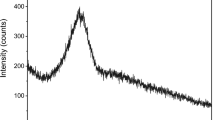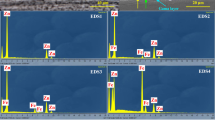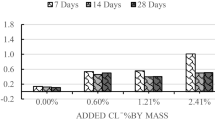Abstract
By using AC impedance spectroscopy (ACIS), this paper studied the changes of electrochemical parameters of cement paste mixed with fly ash (FA), ground blast furnace slag (GBFS) and silica fume (SF) during the process of bending. The results showed that: the AC impedance parameter R s decreased with the increase of stress imposed on the specimens. Under the same condition of W/B and stress, for R s there were group D with SF > group C with GBFS > group A of cement paste > group B with FA, which indicated that the porosity or cracks within the samples were group B > A > C > D, and with the increase of stress, the change rate of R s of group D, C and A was less than group B. At the same time, ultrasonic method was used to test the changes of sonic time and first wave amplitude during the bending process, and the results are agree with the changes of ACIS parameters.









Similar content being viewed by others
References
Shi, M.: Impedance Spectroscopy of Concrete. China Railway Press (2003)
McCarter, W.J., Gravin, S., Bouzid, N.: Impedance measurements on cement paste. J. Mater. Sci. Lett. 7, 1056–1057 (1988)
Mccarter, W.J., Brousseau, R.: The AC response of hardened cement paste. Cem. Concr. Res. 20, 891–900 (1990)
Brantervik, K., Niklasson, G.A.: Circuit models for cement based materials obtained from impedance spectroscopy. Cem. Concr. Res. 21, 496–508 (1991)
Li, X., A, R., Yan, P.: Research on hydration degree of cement-FA complex binders. J. Build. Mater. 13, 584–588 (2010)
Zhang, Y., Shi, M.: Study of the hydration process of cement-based materials by AC impedance technique. J. Build. Mater. 3, 109–112 (2000)
Shi, M., Chen, Z.: Study of AC impedance on the pore structure of hardened cement paste. J. Build. Mater. 1, 30–35 (1998)
Shi, H., Fang, Z.: Influence of FA on early hydration and pore structure of cement pastes. J. Chin. Ceram. Soc. 32, 95–98 (2004)
Zhang, Z., Shi, M.: Study of cementitious activity of granulated blast furnace slag by AC impedance technique. J. Build. Mater. 8, 583–585 (2005)
Zhang, Z., Shi, M.: Study of hydration mechanism of mineral admixture in concrete by AC impedance technique source. J. Build. Mater. 9, 366–369 (2006)
Tian, M.: Study on electrical impedance of hardened cement paste with crack. Dissertation, Sichuan University, China (2006)
Gu, P., Xu, Z., Xie, P., Beaudoin, J.J.: An AC impedance spectroscopy study of micro-cracking in cement-based composites during compressive loading. Cem. Concr. Res. 23, 675–682 (1993)
Li, W.: Frequency-spectrum analysis of ultrasonic testing signal in concrete. Nondestructive Testing of Concrete Elements and Structures, 104–114 (1992)
Bungey, H.: Ultrasonic testing to identify alkali-silica reaction in concrete. Br. J. Non-Destr. Test. 33, 227–231 (1991)
Maslouhi, A.: Fatigue crack growth monitoring in aluminum using acoustic emission and acousto-ultrasonic methods (Special issue: Advanced Materials and Structures Response Prediction and Monitoring). Struct. Control Health Monit. 18, 790–806 (2011)
Hatanaka, H., Kawano, Y., Ido, N., Hato, M., Tagami, M.: Ultrasonic testing with advanced signal processing for concrete structures. Nondestruct. Test. Eval. 20, 115–124 (2005)
He, F., Wang, Z., Shi, L.: Ultrasonic testing technique for the inspection of defects in the corner of composites. J. Mater. Eng. 7, 80–84 (2011)
Gu, P., Xu, Z., Xie, P., Beaudoin, J.J.: Application of AC impedance techniques in studies of porous cementitious material. I. Influence of solid phase and pore solution on high frequency resistance. Cem. Concr. Res. 23, 531–534 (1993)
Prassianakis, I.N.: Ultrasonic testing of non-metallic materials: concrete and marble. Theor. Appl. Fract. Mech. 42, 191–198 (2004)
Acknowledgements
The authors would like to acknowledge the financial support provided by China 973 project “the basic research of environment-friendly in modern concrete (No. 2009CB23201), Beijing Natural Science Foundation (Granted No. 8100001), and the excellent talent project of Beijing (No. 2009A005015000006).
Author information
Authors and Affiliations
Corresponding author
Rights and permissions
About this article
Cite this article
Li, Y., Sui, Ce. & Ding, Qj. Study on the Cracking Process of Cement-Based Materials by AC Impedance Method and Ultrasonic Method. J Nondestruct Eval 31, 284–291 (2012). https://doi.org/10.1007/s10921-012-0142-z
Received:
Accepted:
Published:
Issue Date:
DOI: https://doi.org/10.1007/s10921-012-0142-z




